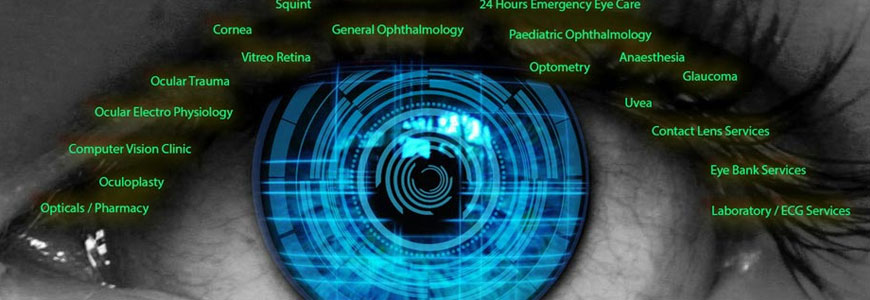Glaucoma Services
- Home
- Glaucoma Services
Glaucoma Services

What is Glaucoma?
Glaucoma results from damage to the optic nerve. Usually the damage is from increased pressure in the eye. The damage to the eye is irreversible and glaucoma can lead to blindness. The most common form, open-angle glaucoma, generally appears in middle age and seems to have a genetic component. In this type of glaucoma, vision loss occurs very gradually. One eye is often worse than the other. Other types of glaucoma are closed-angle glaucoma (a medical emergency) and congenital glaucoma (present at birth). Secondary glaucoma is usually associated with another eye disease or disorder, such as a very mature cataract, uveitis, bleeding, eye tumor, or an eye injury.
Types of Glaucoma
The two major categories of glaucoma are open-angle glaucoma (OAG) and narrow angle glaucoma. The “angle” in both cases refers to the drainage angle inside the eye that controls the outflow of the watery fluid (aqueous) that is continually being produced inside the eye.
If the aqueous can access the drainage angle, the glaucoma is known as open angle glaucoma. If the drainage angle is blocked and the aqueous cannot reach it, the glaucoma is known as narrow angle glaucoma.
Variations of OAG include: primary open angle glaucoma (POAG), normal-tension glaucoma (NTG), pigmentary glaucoma, pseudo exfoliation glaucoma, secondary glaucoma and congenital glaucoma
Variations of narrow angle glaucoma include acute angle closure glaucoma, chronic angle closure glaucoma, and neovascular glaucoma.
But as we age, some of the protein may clump together and start to cloud a small area of the lens. This is a cataract. Over time, the cataract may grow larger and cloud more of the lens, making it harder to see.
Glaucoma Symptoms
Glaucoma often is called the “silent thief of sight,” because most types typically cause no pain and produce no symptoms until noticeable vision loss occurs. For this reason, glaucoma often progresses undetected until the optic nerve already has been irreversibly damaged, with varying degrees of permanent vision loss. But with acute angle-closure glaucoma, symptoms that occur suddenly can include blurry vision, halos around lights, intense eye pain, nausea and vomiting. If you have these symptoms, make sure you see an eye care practitioner or visit the emergency room immediately so steps can be taken to prevent permanent vision loss.
How is Glauocma diagnosed?
Since the treatment methods for open angle and angle closure glaucoma are different, it is important to identify the mechanism involved. The diagnosis (or exclusion) of glaucoma requires a detailed and comprehensive eye examination. At Oracle eyecare doctor will do the following examinations: To detect glaucoma your doctor will do the following examinations: a routine vision test that requires reading letters from a chart, Slit lamp (microscope) examination: This special microscope is the ophthalmologist’s stethoscope and all patients, not just those suspected of having glaucoma, must undergo a slit lamp examination. The pressure inside the eye is measured with an ‘applanation tonometer’ attached to the slit lamp. A hand held version of the instrument is also effective. It may be necessary to obtain multiple readings of the pressure during the course of the day and at night. The older method of resting an instrument on the cornea while the patient lies down is not accurate. The newer non-contact air soft (computerized) instrument may be good for screening but cannot be used for diagnosis or treatment of glaucoma. An examination of the angle of the eye is done with the help of a gonioscope. This is a contact lens placed on the eye to examine the angle of the eye. Its use is mandatory in determining the type of glaucoma – open angle or angle closure.
The above two steps require the use of drops to eliminate the sensation in the eye. The drops may burn a little bit. An optic disc examination on a dilated eye is also required. The doctor will usually instill eye drops to dilate the pupil to facilitate examination of the optic disc and the back of the eye, the retina. For obtaining a stereoscopic view on the microscope a hand-held lens or a contact lens is the best method. A computerized scan of the optic disc may also be done. To confirm the diagnosis, the doctor will conduct an automated field or perimetry test. Damage to the optic nerve limits the field of vision, but regular vision, i.e. the ability to read an ophthalmologist’s eye chart, is affected at a much later stage. In its early stages glaucoma can only be detected or monitored by using an automated perimetry test. A normal patient will have a ‘full field vision’, while a person with glaucoma has black, non-seeing areas in the field of vision. Many people have difficulty doing the perimetry test at first, and may be better at it the second or the third time. Baseline tests are necessary for future comparison and periodic examinations are essential to check the progression of the disease. Considering the importance of the test, ANY automated perimeter is NOT acceptable. The field test is a subjective test and it is important to have a calibrated machine with an appropriate normal database against which to compare your results.
If you Have Any Questions We are Here!! DON'T HESITATE TO CONTACT US ANY TIME.
Have a question? call us now
+91-8006803111, +91-7500503111
We are open on
Mon - Sat: 08:00AM - 08:00PM
Sunday: 10:00AM-4:00PM
Drop an Email
oracleeyecare@gmail.com
Contact Us
- 181 Ram Ganga Vihar, Phase 1 MDA, Near Yuvraj Residency, Moradabad (UP)-244001
- 0591-2453111, +91-8006803111


